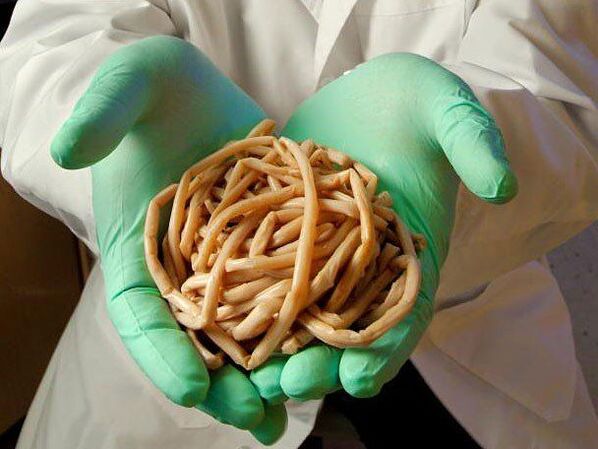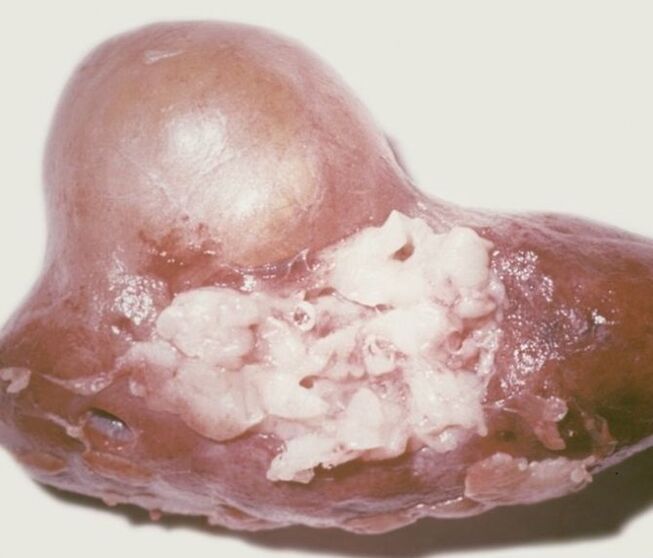Parasites - This is the name of one of the most common groups of infectious diseases.Today, about 300 parasites are known, which is dangerous to people, including a fatal person.These are only a few dozens of parasites in the territory of the European continent (medical name - Helminthias, Helmintic occupation).
The biggest part of the parasites that belong to people is in the countries with a tropical and subtropical climate, as well as the low level of socio-economic development and sanitary culture.
What are the dangerous parasites

The parasites in the human body may affect almost any body system.The degree of harm depends on the type of helminth, the duration of the disease, the initial state of health.The sooner the diagnosis of special helmastic occupation is built and you have a chance to get rid of the parasite quickly.Therefore, it is important to diagnose the situation with parasites in a timely manner and perform all stages of treatment.
Almost any options of Helminthiasis, especially in the human body, especially for a long time.Hlybon Invasion, the reason for the delay in psycho-motor development in children of all ages, significantly reduces the performance and life reserves in adults.
Regardless of the age of a person, Helinik causes occupation of occupation, reduces the ability to resist contagious and other diseases of the immune system, adding the effectiveness of the continued vaccination prevention.
Rarely, the body of the parasites occurs spontaneously, in most cases, a certain treatment requires a certain treatment for this.
What are parasites

Parasites are a multi-colored group of multi-colored organistic organism, which exists in a large number of worms in a variety of conditions (they are worms or worms).An important feature is the ability to exist in another living organism (person or animal) called "occupation".
Currently, different types of parasites are known in the human body.The most common classification of parasites depending on the external structure and the characteristics of the life cycle.
Given the biological features, all parasites are divided into 3 large classes:
- Round worms (they are also nematods), for example, Trathinella, Ankilostoma, Pin, Ascaris;
- Ribbon worms (they are also cessodes), for example, alveococcus, echinococcus, ribbon wide, bull-clinical tape, pork and dwarf;
- For example, Supers in Opistorch, Faschiol, Clonorch (they are also memrootic).
In addition, as many other diseases, parasitic diseases are different:
- violently;
- by the leading syndrome, that is, the system of the bodies is more damaged;
- with the presence and character of complications;
- By the possible result of the disease.
Features of parasites
Development phase
Parasitic diseases are characterized by parasites and a number of differences related to the characteristics of their life cycle.
The number of adults of parasites in the human body is not increased, there is no new infection.Most of the parasites for the implementation of the life cycle require the change of habitat (animal body, land, etc.).
Typical stages of development for any parasite.Throughout the life cycle, Helminth passes a series of consecutive stages.As a rule, the parasite egg is made into a larva and then becomes a mature person.The opposite development does not occur, the eggs cannot immediately pass to the stage of an adult.
The parasite penetrates the human body in a stage of life and goes beyond the other.At the moment, human parasitic diseases are unavoidable.That is, it is impossible to be infected with a majority of parasitic diseases in direct contact with an infected person.
Possible ways of reputation to the human body
With many kinds of parasites, a person can meet everywhere - they do not appear naked.The following options are most likely to:
- oral way related to the use of individual hygiene, dirty or heat-free products;
- The percutaneous road, that is, the larvae of parasites or adults connect to water or soil, in connection with water or soil, damage to the human body.
The majority of parasites affecting the human body only live in the elderly stage, mainly in the digestive system.These are so much intestinal parasites (Helminths).In turn, they are divided into 2 groups in accordance with some features.
Intestinal parasites of the first group enter the human body in eggs.They turn into an adult person in the digestive system.The actions of such parasites (pinworms, wide ribbons, pork and bull tapeworm) are limited only by different departments of the digestive system.
Representatives of the second group (larvae or eggs) carry out considerable long and complex migration due to various tissues and human body agencies.Only then is the parasite a person.The symptoms of such parasiton diseases are more different, as the migration process is associated with significant changes in the body.
The parasites located on the edge of the digestive tract in a mature or larva stage are called tissue.If a parasite in the human body is only a parasite on the stage of larvae, a person for him is the end of the ecological dead that Helmint could not leave.
Features of the life cycle of parasites
To know how to get rid of parasites in the body, the life cycles should be represented in general conditions.This knowledge also helps prevent parasites to prevent entering the human body.
In line with the characteristics of the life, all parasites are divided into:
- Geo Parasites;
- Contagious helminthosis;
- Bio Helminthiasis.
Geo Parasites (vlasov, inclination) need to be a certain period of time in the soil to carry out the life cycle.In direct contact with dirty soil in the future, the use of enough wash vegetables through dirty hands, parasites penetrate the human body.
In the contagiosteal parasites (pinworms, dwarf tabells), all stages of development are only in the human body, the surrounding changes.Only this type of parasitic diseases are transmitted directly from the person.Especially in childhood, as well as childhood, which is in the event of facing hygiene rules and skills, ie.
It's so complex life cycle, so much in the biogelminosis.A condition for the implementation of the life is the presence of the intermediate owner.A person can either be intermediate or a final master.For example, a person with Echinococcoz is a homeowner, dogs and cats are the end.In the case of a tusherinchosis, on the contrary, the cattle representatives are intermediate hosts and a human being in the final.
Symptoms of parasites
Clinical signs of the parasites are determined on the one hand, on the other side, due to the prevailing authority, have common features that allow you to distinguish the sharp and chronic phase of a parasiton.
The sharp phase of the parasitory is in accordance with the migration stage of Helmint development.Allergic and common toxic reactions (ascariasis, schistosomosis, fackiolesis, fackiolesis, trichineellosis) are self-evident by clinical signs.
The immunological component has a significant weight in the development of a sharp phase of parasitosis, some similarities with a certain stereotype and other immunological reactions of non-sufficient nature - medicinal, allergic dermatitis and others.
The hidden period with the most parasitosis is a few weeks, the mass of infection is reduced to 7-10 days and extends with weak intensity.
The main symptoms of parasitic diseases are as follows:
- Increasing body temperature - very high than subberry;
- Pain in muscles and joints, different periods and intensity;
- The formation of a rash on the entire surface of the skin is different and intensity accompanied by skin itching;
- Skin and subcutaneous tissue, less frequent - mucous membranes;The disease is the most typical for trichineellosis that gives a popular name of the "swollen" characteristic;
- Coughing of pulmonary syndrome, ie coughing, asthmitoid states, pneumonia, which is a center of treatment;
- Development of the abdominal syndrome characterized by the perfect abdominal pain, mucus and liquid stool without blood violation;
- In severe cases, it is observed to the central nervous system and the heart;
- A different feature of Helminthiasis is a change in peripheral blood: leukocytosis and significant eosinophilia (up to 30-40%) are pronounced.
The most effective in the treatment of drugs from the parasites in the human body.
In the phase of the chronic phase of parasitic diseases, harmful effects are determined by the type of adult parasites.The negative impact on the human body is linked:
- Great toxic and less allergic effects;
- Mechanical damage to tissues in the parasitation zone (eg, liver vacinococospitation);
- Development of food items, violation of metabolic processes, anemia and cachexia;
- heavy anemia;
- an increase in irritation and excitement of a person;
- It is possible to join the second grade infection and dispensa, other infectious and insufficient diseases, as well as the weight of pregnancy.
The existence of individual parasites is different - from a few days and for many years (cutters).Againstreacle is possible because it is not immunity after parasitic disease.Therefore, cleaning of one of the parasites of the body is not protected from the re-episode of the disease.
Treatment of parasites

Currently, the classic medication treatment of parasitosis has become an important success.Access to the clinical practice of benzimidazole and iMidazole combinations allowed you to successfully treat many of the Helminti.
It is convenient to use a wide range of medications with a wide range of medications, a wide range of small toxide, adults and children.The relevant age of the dose of drugs should be observed.
How to cleanse the body of a particular parasite is to solve what treatment regimen and the medication by the doctor.The drug initiative is not recommended to prevent helminthiasis, which is a decrease in their effects, that is, a decrease.
Cleaning of parasites
With parasitosis, treatment with folk treatment is not less popular than traditional medicines.Supporters of natural means for parasiton diseases were focused on the security and universality of such therapy.There is a traditional drug recipe in the human body, which is quite effectively affected by the parasites.The following options are the most popular to eliminate the parasites in the human body:
- Coriander and pumpkin seeds as a preventative and therapeutic agent for panazites;
- Alcohol tincture in Chanterelles combined with white mushrooms;
- a decoction of candlestick cones;
- Tincture of the green nut.
Any folk treatment for parasites should fit the recipe and clean hands.It is important to make sure that a person has not had allergies to substances, before choosing a particular recipe.
How to protect yourself from parasites

At the same time, it is both easy and difficult.Several simple rules will help minimize the risk of infection with any parasite:
- wash your hands thoroughly;
- the right to use a set of individual dishes;
- The warmth and fish processes and fish processes and fish by heat and fish using their fish and meat people;
- Treat vegetables and fruits with boiling water (after being washed in water);
- Wash your hands with soap after communication with animals (even local).
The parasite infection of any age is an unpleasant problem, but it is completely eliminating early treatment.






































